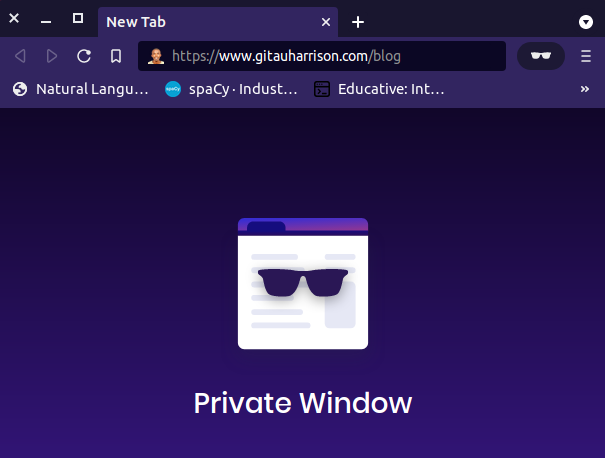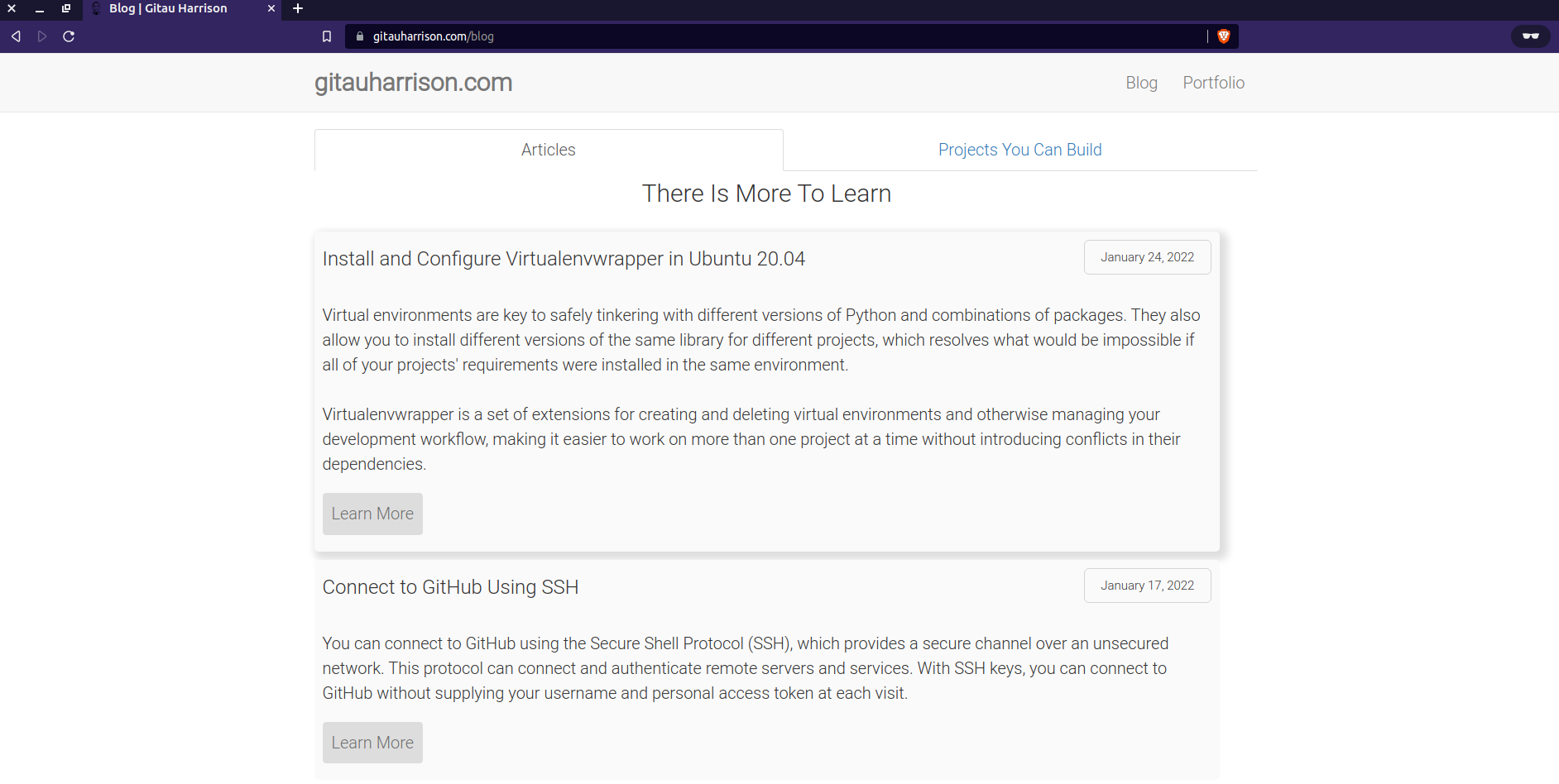HTTP Life Cycle
You probably are curious to know what happens when you type in a query in your browser's URL address bar and hit Enter. Similarly, you may have just finished deploying your application on a server and you may be curious to understand how your application interacts with the server. In this article, I will break down the entire HTTP operation so that you can understand how it works. This operation is called the HTTP Life Cycle.
What We Will Look At
I will use my personal blog as an example to explain how the HTTP cycle works. To access my blog, I can type the URL https://www.gitauharrison.com/blog in my browser's address bar.

When I hit enter on my keyboard, this is what I get:

So, what happened? From the above URL, https is the protocol, www.gitauharrison.com is the host (domain name) and /blog is the resource path. Domains are mapped to the IP address of the host. Rather than remembering an IP address such as 142.250.203.206, it is much easier to remember a name such as google.com. Read more on host names here.
Since the browser now knows what host it is trying to reach, which is www.gitauharrison.com, it will try to connect to the server. The steps involved in resolving the Domain Name System (DNS) include:
First, the browser checks its local cache to see if the host mapping already exists. If it does, then it will respond by returning the content of the cached host mapping.
If the host mapping does not exist in the browser cache, DNS resolver checks the Operating system level cache. An operating system keeps its own DNS resolution for websites that were recently surfed by different clients on that machine.
If the record does not exist in the OS cache, then the Internet Service Provider (ISP) cache is checked. An ISP cache is a cache that is maintained by the ISP.
If the record does not exist in the ISP level, then a query is made to the DNS server over the internet for that particular resource.
Composition of a URL
A URI (Uniform Resource Identifier) is a string of characters that identifies a resource on the Internet. A URL (Uniform Resource Locater) is a type of URI that identifies a resource based on its location rather than its name or attribute. The URL is composed of the following parts:
- Scheme: It identifies the protocol used to access a resource on the internet. This can be HTTP or HTTPS.
- Host: A host name identifies a host that holds a resource, for example,
www.gitauharrison.com. - Path: A path identifies a specific resource on the host. For example,
/blog. - Query String: A query string is a string of characters that is appended to the URL after the path, for example,
?page=1. This will return only the contents found in page 1 of the blog. - Fragment: A fragment is a string of characters that is appended to the URL after the query string, for example,
#comments. The blog page might have a section called comments. If I want this particular part of the blog page, then the URL would look likehttps://www.gitauharrison.com/blog?page=1#comments.
The structure of a HTTP URL looks like this:
scheme://host:port/path?query#fragment
Hosts can be followed by a port number. The port number is optional. If it is not included, then the default port number is 80. Well known port numbers are normally not included in a URL. Example ports include:
| Service | Port Number |
|---|---|
| Hypertext Transfer Protocol (HTTP) | 80 |
| HTTP with Secure Sockets Layer (SSL) | 443 |
| File Transfer Protocol (FTP) | 21 |
| Telnet | 23 |
The HTTP Protocol
The correct HTTP fortmat depends on the version fo the HTTP protocol. There are two formarts:
- HTTP/1.0: earlier protocol with fewer functions
- HTTP/1.1: later protocol with more functions
HTTP request is normally made by a client to a named host located on the server, with the aim of requesting to access a resource on the server. HTTP response is made by the server to a client who made a request, the aim being to provide the requested resource. All these actions are referred to as requirements. A client or server that fulfills the requirements for its version of the HTTP protocol is said to be compliant with the HTTP specification.
HTTP Requests
It is made by a client to a host wanting to access a resource on the server. The request is made by sending a message to the server. The message is composed of the following parts:
- Request Line: The first line of the message. It contains the method, the resource path and the HTTP version.
- Header Fields: The header fields are the key-value pairs that are sent with the request.
- Message Body: The message body is the content of the request.
Request Line
It is the first line in a request message. It contains the method, the resource path and the
- Method: The method is the type of request telling the server what it should do. For example, a server could be asked to send the resource to a client. The most common methods are GET, POST, PUT(replace), DELETE, and PATCH(modify).
- Resource Path: The resource path is the path of the resource that the server is asked to send. For example, if the resource path is /blog, then the server is asked to send the contents of the blog.
- HTTP Version: The HTTP version is the version of the HTTP protocol that the client is using. For example, if the HTTP version is HTTP/1.1, then the client is using the latest version of the HTTP protocol.
An example of a request line is:
GET /blog?page=1 HTTP/1.1
A request line my contain the scheme, host and a query string components. If so, then it is known as the absolute URL. For HTTP/1.1, if the host component of the URL is not included in the request line, it must be included in the header fields of the message.
Header Fields
The header fields are the key-value pairs that are sent with the request, providing the recipient with information about the message, the sender, and the way the sender wants to communicate with the recipient. Each HTTP header must have a name and a value. A server can use the header fields to decide how to repond to a client's request.
Example of a header field:
Accept-Language: en-US If-Modified-Since: Sun, 30 Jan 2022 06:20:00 GMT
Here, the end user only wants to read the requested resource in American English and that the document should only be sent if it has been modified since the date specified.
The header fields are separated by a new line. The header fields are sent in the order they are presented in the message. The header fields are terminated by a blank line.
Message Body
This is the actual content of the request. For example, if the request is a GET request, then the message body is most likely to be empty. For example, if the request is a POST request, then the message body is the data contained in the form.
HTTP Responses
They are made by a server to a client. The aim is to provide the client with the requested resource, or inform the client that the request was successful or there was an error processing it. The response is composed of the following parts:
- Status Line: The first line of the message. It contains the status code and the reason phrase.
- Header Fields: The header fields are the key-value pairs that are sent with the response.
- Message Body: The message body is the content of the response.
Status Line
The status line is the first line in a response message. It contains the status code and the reason phrase. The status code is three-digit number that indicates the result of the response. The reason phrase is a short human-readable phrase that describes the status.
An example of a status line is:
HTTP/1.1 200 OK
The HTTP version used in the response is HTTP/1.1. The status code is 200. The reason phrase is OK. The status codes are classified by a range of numbers.
| Status Code | Meaning |
|---|---|
| 100 - 199 | Informational |
| 200 - 299 | Success |
| 300 - 399 | Redirection |
| 400 - 499 | Client Error |
| 500 - 599 | Server Error |
There are no specifications for codes above 599.
Header Fields
The header fields are the key-value pairs that are sent with the response, containing information that a client can use to find out more about the response and about the server that sent it. This information could help the client with displaying the response to a user.
An example of a header field is:
Date: Sun, 30 Jan 2022 06:20:00 GMT Server: Apache/2.4.18 (Ubuntu) Content-Type: text/html; charset=utf-8 Content-Length: 5 Connection: close
The response above tells the client what time it was sent, the server that sent it, the type of the content, the length of the content, and the connection type.
If the request was unsuccessful, headers can be used to tell the client what the error was and how it can be resolved. An empty line is placed after the header fields to separate it from the message body.
Message Body
The message body is the content of the response. The message payload of a succesfully processed request will contain the resource requested by the client. For example, if the client requested the resource at /blog?page=1, then the message body will contain the contents of the blog found on page 1. However, if the request was unsuccessful, the message body will contain the error message and some actions a client can take to complete the request successfully.
Further Reading
Host Names
A website (also known as a host) can be indentified on the internet by a host name such as www.gitauharrison.com. They are sometimes called domain names. These names are mapped to an IP (Internet Protocol) address.
A host name is used by a client to make a HTTP request to a host. The user, the person making the request, can specifiy to use the IP address of the host name but it is more conviniet to use the host name. This is because the host name can be remembered easily.
Share
If you enjoyed this article, you can share it with another person.
TweetNewsletter Subcription
Level up your skills.
We take your privacy seriously. Read our privacy policy. Unsubscribe | Resubscribe.




